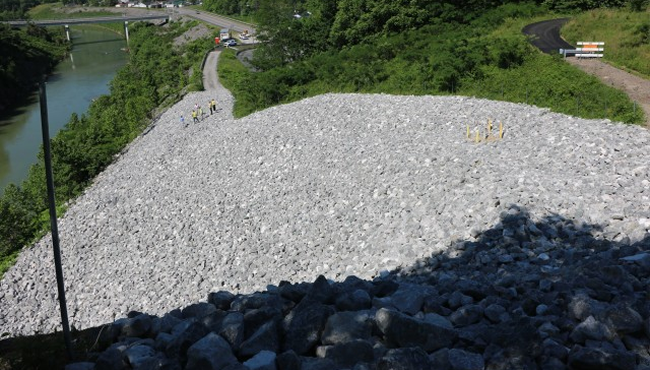Start the week with the latest in the geoengineering world. Here’s the GeoWire conversation for the week of June 15. WORK SMARTER.
BIG PROJECTS
On June 8, the California State Assembly approved an expedited USD $576 million for the much needed Anderson Dam Seismic Retrofit Project. The bill’s author, Assemblyman Robert Rivas (D-Hollister, Calif.), warned of “catastrophic” failure if a large seismic event were to occur.
Contracts on the main remediation works at the massive Giant Mine Remediation Project in Canada continue to get closer. Significant geosynthetics will be used in the management of the old tailings and environmentally securing the site.
Singapore Business Review highlights how the country is resuming mega infrastructure projects, such as Changi T5, Tuas Mega Port, and submarine cable hubs.
ENVIRONMENTAL IMPACT
The Canadian Geotechnical Journal has published online “Longevity of Twelve Geomembranes in Chlorinated Water” from Morsey, Rowe, and Abdelaal. The paper marks yet another solid addition to the field from the GeoEngineering Centre at Queen’s/RMC.
Dave Petley at the Landslide Blog writes about a new paper showing how “rainstorms tend to trigger landslides that sculpt mountain chains at lower levels, whilst earthquake induced landslides cause erosion at higher elevations.”
There is a substantial “country effect” on erosion around the world. Fascinating research story over at ETH.
FINANCE
Bloomberg reports that Macquarie Infrastructure and Real Assets is raising ~$3 billion for investments in Asia in transportation, communications, utilities, energy, and waste management.
Austin, Texas notes that its transit infrastructure was not designed to handle the current 2 million residents … nor the expected doubling of that population by 2040. Major new transportation investments are in development. (See more under Government below.)
AECOM’s CEO Michael S. Burke and Special Consultant Clive Lipschitz explore public-private partnerships, greenfields development, regional infrastructure plans, and more as they propose practical steps to funding future infrastructure.
GEOSYNTHETICS
The US Army Corps of Engineers (USACE) recently completed a slope failure reconstruction in Kentucky that required the relocation of multiple graves, including one of an American Revolutionary War veteran who had been present at Valley Forge and Yorktown.

The Canadian Geotechnical Society (CGS) has launched the official GeoVirtual 2020 website! GeoVirtual 2020 will host the CGS annual conference entirely online and live September 14 – 16.
Congratulations to our long-time friend Chip Fuller! We saw on LinkedIn recently that Chip has joined Earth Retention Systems. We knew you couldn’t hack retirement! 🙂
GOVERNMENT
Though Geosynthetica works globally, our home is in Austin, Texas. We sure hope the transportation engineering experts and materials providers to this sector are keeping an eye on the Texas Transportation Plan 2050, which will come into greater focus this year and quickly reshape infrastructure investments.
The International Council on Mining & Metals (ICMM), a non-governmental organization, continues to update its responsible sourcing guidelines, with strong guidance from NGOs and the UN Sustainable Development Goals.
JOBS
TenCate Geosynthetics has a few open positions, including a remote position as a technical manager for roadway systems.
Atlas Technical Consultants seeks a geosynthetic lining system inspector in Alabama.
Stantec is seeking geosynthetics quality assurance personnel.
TECHNOLOGY
Paul Netter, writing for Southern California Edison’s publication Energized, details how drones are being used for monitoring dam integrity. They are used for erosion checks, pipeline safety, 3D modeling that is more complicated and revealing than visual inspection, etc.
We saw a lot of amazing scanning technology at the GAP 2019 transportation conference and again at GeoCongress 2020. The use of tech to efficiently evaluate road bases, construction operations, railway track ballast, etc. is greatly speeding up work. In Canada, a 5km highway was finished 17 days early with the help of 3D scanning assistance.
The Global Wind Energy Council posts hour-long insights into wind energy projects and markets around the world on its YouTube channel. Geosynthetics are utilized in on- and off-shore installation.
This is the June 15, 2020 GeoWire from Geosynthetica. GeoWire is published on Mondays with thought-leading links to help infrastructure professionals work smarter. News and ideas to share? Contact us.
Previous GeoWire Editions
June 8, 2020
June 1, 2020












